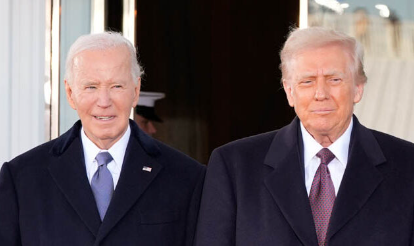A new memo from veteran Democratic strategist Doug Sosnik argues Donald Trump’s path to victory is narrow, but a top GOP pollster says that analysis misses the bigger picture.
What to Know
- Veteran Democratic strategist Doug Sosnik released a memo arguing that Donald Trump has a hard "ceiling" of support that makes his coalition fragile.
- Sosnik's analysis points to Trump's high unfavorability ratings and the intense political polarization he inspires as the main factors limiting his growth.
- In response, Chris Wilson, CEO of the GOP data firm EyesOver, published a critique arguing that Sosnik’s model is outdated and misreads the current electorate.
- Wilson contends that what Sosnik calls a ceiling is actually a very high floor, and that Trump is making significant inroads with new voters motivated by different issues.
- This debate highlights a central strategic question for both parties.
A widely circulated memo from Doug Sosnik, a longtime adviser to President Bill Clinton, is framing the central debate of the current political cycle. In "How Trump Is Fueling the Most Important Trend in American Politics," by Politico, Sosnik argues that while Donald Trump maintains a historically durable base of support, he is hemmed in by a hard ceiling of voters who will not support him under any circumstances.
This dynamic, Sosnik contends, creates an incredibly narrow path to victory for the former president, one that is highly dependent on turnout and the performance of third-party candidates.
However, not everyone is buying this analysis. In a direct rebuttal, Chris Wilson, a leading Republican pollster and CEO of EyesOver, argues that the "ceiling" narrative is a misreading of the data. He suggests that the political landscape has shifted dramatically and that Trump's coalition is not static, but expanding in surprising ways. This clash of perspectives reveals a fundamental disagreement about the nature of the American electorate and the strategies required to win in the current political era.
The Case for Trump's Ceiling
Sosnik’s argument is grounded in a traditional understanding of presidential politics, where elections are won by persuading undecided voters in the center. According to his research, the electorate is now in a state of "stable polarization," with very few voters up for grabs. Within this locked-in environment, Trump’s high personal negatives and the consistent opposition to him from a majority of the electorate create a mathematical ceiling on his support.

President Donald J. Trump; screenshot from video on X
The key takeaway from Sosnik's analysis is that Trump's campaign is not about persuasion, but almost entirely about mobilization. His strategy is to energize his base to such a degree that it overcomes the numerical advantage of the broader anti-Trump coalition.
This makes the election a battle of turnout, where factors like voter enthusiasm, third-party candidates, and the mood of the country on Election Day become disproportionately important. For Democrats, Sosnik's memo is a call to action, reinforcing the idea that if they can successfully mobilize their own coalition, they can defeat Trump.
The Counterpoint: A High Floor, Not a Hard Ceiling
Chris Wilson and his firm EyesOver directly challenge Sosnik’s premise. In a recent “Weekly Snapshot,” Wilson argues that Sosnik's data, while historically accurate, fails to capture the unique dynamics of the current election.

Chris Wilson; LinkedIn; EyesOver
He contends that the focus on a "ceiling" is misleading. Instead, he argues, we should be looking at Trump’s incredibly high and stable "floor" of support, which is something no other modern political figure has enjoyed.
Wilson’s firm presents data suggesting that Trump is not just holding his base, but is actively expanding it by attracting new voters, particularly among working-class and minority communities who are motivated by economic concerns and cultural issues.
He writes, "While Sosnik looks at the large number of voters who say they won’t vote for Trump, we are looking at the even larger number of voters who say they won’t vote for the incumbent".
Wilson's analysis suggests that the election is not a simple question of base vs. base, but a more complex realignment where Trump is pulling in voters who have traditionally voted Democratic.
EyesOver by the Numbers
Sentiment analysis, as demonstrated by the latest EyesOver snapshot, continues to prove more effective than conventional polling. As of September 4, 2025, the firm had logged more than 2.4 million data points from the 2024 cycle, with a national prediction of Trump +2.45 versus an actual result of Trump +1.5, which was a difference of just 0.95 points. That near-perfect call has helped EyesOver secure 45 national industry awards since 2019.

Image by DALL-E; data by EyesOver
The platform’s stated margin of error ranged from 0.3 to 3.5 points, and its issue-level accuracy was even sharper. In Senate contests, EyesOver’s deltas came within a single point in Montana (0.08), Pennsylvania (0.70), and Ohio (0.89). Over the past 100 days, the firm’s sentiment tracking has shown Trump maintaining an advantage on the economy (45% to 39%) and foreign policy (41% to 34%).
 Image by DALL-E; data by EyesOver
Image by DALL-E; data by EyesOver
The takeaway is simple: EyesOver continues to prove that real-time voter sentiment, not static polling averages, offers the clearest window into electoral behavior and issue momentum heading into 2026.
Wrap Up
This debate between two top strategists gets to the heart of the current political landscape. If Sosnik is right, the outcome of future elections will be determined by a small number of swing voters in a handful of states, and campaigns will be brutal, high-stakes battles of inches. The focus for both sides will be on turning out their existing supporters while trying to peel off just enough votes from the margins to win.
But if Wilson’s analysis is more accurate, we are in the midst of a more significant political realignment. In this scenario, the traditional rules of campaigning may not apply. Trump's ability to connect with a new, populist-driven coalition could render the idea of a "ceiling" irrelevant. For campaigns and voters preparing for 2026 and beyond, the question is whether to view elections through the familiar lens of the past, or as the start of a new chapter in American politics. The answer will determine not just who wins, but how elections are fought for years to come.






